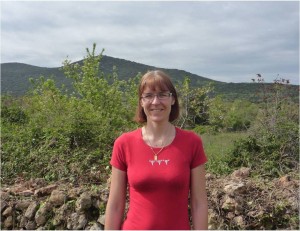 Sophie Monge obtained her Ph.D. in 2000 at the University of Montpellier 2 (France). She was then awarded a Marie Curie fellowship for a postdoctoral position (two years) in the group of Prof. Dave Haddleton at the University of Warwick (UK), working on atom-transfer radical polymerisation. In 2002, she became an associate professor at the “Engineering and Macromolecular Architectures” team (Prof. J.-J. Robin) of Institute Charles Gerhardt in Montpellier. Her research interests mainly focus on the synthesis of well-defined (co)polymers with stimuli-responsive properties, and with polymers bearing heteroatoms, in particular phosphorus.
Sophie Monge obtained her Ph.D. in 2000 at the University of Montpellier 2 (France). She was then awarded a Marie Curie fellowship for a postdoctoral position (two years) in the group of Prof. Dave Haddleton at the University of Warwick (UK), working on atom-transfer radical polymerisation. In 2002, she became an associate professor at the “Engineering and Macromolecular Architectures” team (Prof. J.-J. Robin) of Institute Charles Gerhardt in Montpellier. Her research interests mainly focus on the synthesis of well-defined (co)polymers with stimuli-responsive properties, and with polymers bearing heteroatoms, in particular phosphorus.
Website of the lab: www.iam.icgm.fr
What was your inspiration in becoming a chemist?
I was immediately interested in Chemistry when I started to learn it at school. What I really enjoyed was to achieve some little experiments. So I asked my parents to buy me a Chemistry lab playset but they never did. I think that they were frightened about what my brother and I could do with it…
What was the motivation to write your Polymer Chemistry article ?
In our team, we have been interested since a long time on phosphorus-based polymers. I am notably currently working on a book named “Phosphorus-based polymers: from synthesis to applications” as a co-editor which will be published soon by the RSC. We also have a great expertise on controlled radical polymerisation. As a consequence, we thought that combining both phosphorus and RAFT was a good idea to achieve polymers with well-controlled architecture, thus leading to interesting properties of the produced materials. In our article (DOI: 10.1039/C3PY00426K), we notably describe for the first time the controlled polymerisation of a phosphonated containing methacrylate, namely the dimethyl(methacryloyloxy)methyl phosphonate (MAPC1), by the RAFT process. This work is of great interest as successful “living” radical homopolymerisation of MAPC1 and related monomers was never reported in the literature. Additionally, we recently reported the RAFT polymerisation of phosphonated-based acrylamide in another paper also published in Polymer Chemistry (Polymer Chemistry, 2013, 4, 795).
Why did you choose Polymer Chemistry to publish your work?
I consider Polymer Chemistry as a leading journal in the field of polymers, with a broad audience. Impact factor is excellent, reviewers’ comments are very constructive and publication is very fast.
In which upcoming conferences may our readers meet you?
I will be attending the 34th Australasian Polymer Symposium at the beginning of July (7th – 10th July 2013) which will be held at Darwin, in the Northern Territory of Australia. I will notably speak about RAFT polymerisation of phosphonated-based monomers.
How do you spend your spare time?
I spend my spare time with my two daughters and my husband. We enjoy being all together, at the moment gardening, especially growing some tomatoes and strawberries in our vegetable garden.
Which profession would you choose if you were not a scientist?
I think I never thought to do something else, really. But I would have enjoyed being a pianist, even if I never learned to play… but it is not too late to do it!
Cyrille Boyer is a guest web-writer for Polymer Chemistry. He is currently a Senior Lecturer and an ARC-Future Fellow at the Australian Centre for NanoMedicine and Center for Advanced Macromolecular Design (School of Chemical Engineering, University of New South Wales (Australia)).










